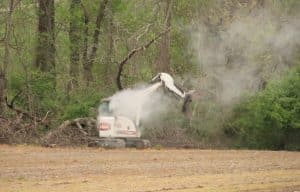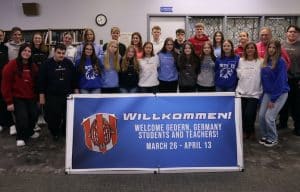New book documents historic trail

Dennis Patton
Retired Columbia High School Principal Dennis Patton has released his new book titled “The Kaskaskia-Cahokia Trail.”
The book, which is now available, is the culmination of seven years of writing.
But the idea for the book has been germinating in Patton’s mind since shortly after 2008, when he was appointed to the Columbia Heritage Preservation Commission.
Not long after, the history lover and his friend, Terry Schramm, bought Sand Bank School in Columbia. In 2010, while going through the school’s records, Patton saw a mention of the Kaskaskia-Cahokia Trail.
That inspired Patton to research the trail. While doing so, he found a Landmarks Illinois article from 2000 in material from the Columbia Historical Society naming the trail as one of the most endangered historic places in the state.
“When I saw that I thought, ‘this trail must have been important if they think it’s one of the most endangered things in Illinois,’” Patton said. “So that kind of prompted me to get started.”
So, Patton began reading everything he could about the Kaskaskia-Cahokia Trail.
As he conducted his research, he compiled about 1,000 pages of typed notes. He also gave presentations to local governing bodies and organizations about the trail.
“Nobody really knew much about it,” said Patton, whose previous book, 2012’s “School Days,” recounted the history of schools in Columbia and Monroe County.
Patton led the commission’s attempts to save the trail, earning the commission the Landmarks Illinois Foundation Richard H. Driehaus Foundation Preservation Award in the process.
Patton then formed the Kaskaskia-Cahokia Trail Coalition.
After taking all these steps, Patton and his wife, Sue, moved to Florida.
His work on the trail did not end, however, because the Columbia Historical Society and the Sophia and Elmer Oerter Charitable Foundation of Columbia asked him to write a book.
“When you’re laying on the beach for four years and you don’t have a lot to do, you start writing a book,” Patton joked. “So I took that 1,000 pages and I reduced it down to 360 pages of material.”
The tome chronicles the history of the trail. The story begins in 1300 B.C. with the Mississippian Indians, who had a trail almost identical to the Kaskaskia-Cahokia Trail.
Patton said he conducted most of his research online through the library catalog WorldCat and the Library of Congress. His sources included books, interviews, school records, a journal written in 1796 and a map from 1734.
Patton said he enjoyed conducting all the research necessary to tell the entire history of this trail.
“My favorite part of doing the book was doing the research,” he said. “I love that. Then it was pretty exciting to whittle the information down.”
The book also focuses on the early 1800s, when the trail was the main thoroughfare in the area. Today, Route 3 in large part retraces the route of the Kaskaskia-Cahokia Trail, one of the oldest roads in Illinois.
Patton said that historical significance of the trail is why people should read the book.
“The Kaskaskia-Cahokia Trail was the lifeblood of Illinois,” he said. “From 1700 until Illinois became a state, the state of Illinois was the area from Kaskaskia to Cahokia. That’s where the state began… From there, they moved north and populated the state of Illinois.
“It’s just a story I think anybody interested in history would be interested in.”
He said the trail is worth preserving for similar reasons.
“The road’s important because it was the lifeblood of the growth of Illinois,” Patton said. “The stories I found about the early pioneers are worth reading so that our young people can look at the history and see the significance of the way our country was formed – the hard work and efforts our forefathers put in. If we forget those things, which we tend to do, it’s really hard to know where you’re going in the future if you don’t know where you’ve been in the past.”
“The Kaskaskia-Cahokia Trail” will be available at the Republic-Times office in Waterloo and Roseberry Farms in Columbia.
Proceeds from book sales at the R-T office will go to the Kaskaskia-Cahokia Trail Coalition. People may pay with cash, check or charge.
Proceeds from books bought at Roseberry Farms will benefit a historic signage project related to the trail in Columbia. The Columbia Historical Society, Columbia Heritage and Preservation Commission and Historic Main Street Columbia Association are teaming up for that effort. Cash, check or charge are also acceptable at Roseberry.
Copies of the book will also be on sale at Columbia FestiFall on Sept. 30 and at Waterloo PumpkinFest on Oct. 13 to benefit the Historic Main Street Columbia Association and Kaskaskia Cahokia Trial, respectively.
The book sales can all be donated because the Oerter Foundation paid for the publishing of the books.
The leather-bound hardback will include black and white pictures and cost $40.
Supplies are limited, as there are only approximately 180 books total for sale.
Copies of the books will also be available at the libraries in Chester, Waterloo and Columbia.
To learn more about the trail, including seeing excerpts from the book, follow the Kaskaskia-Cahokia Trail on Facebook.






